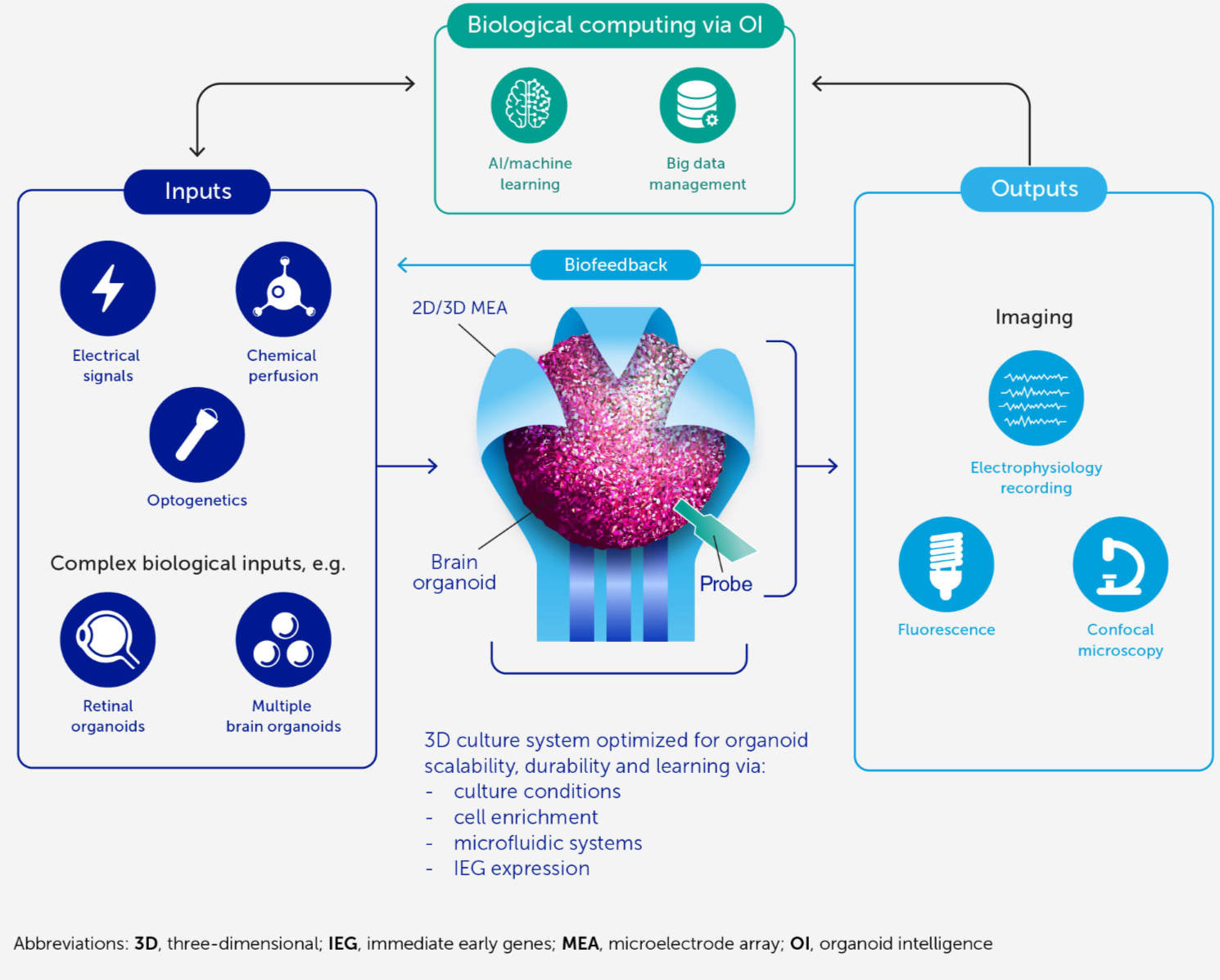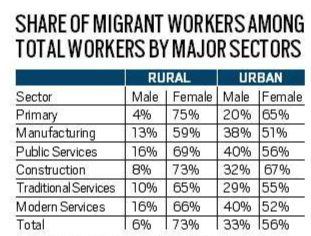Science & Technology
Organoid Intelligence and Bio-Computers
For Prelims: Organoid intelligence, Potential uses of Bio-computers.
For Mains: Threats and opportunities of Organoid-culture.
Why in News?
Recently, Scientists have outlined a plan for a potentially revolutionary new area of research called “organoid intelligence”, which aims to create “biocomputers”, where 3D brain cultures grown in the lab are coupled to real-world sensors and input/output devices.
- Technology is expected to harness the processing power of the brain and understand the biological basis of human cognition, learning, and various neurological disorders.
What is this Technology?
- These “mini-brains” (with a size of up to 4 mm) are built using human stem cells and capture many structural and functional features of a developing human brain. It is used to study human brain development and test drugs to see how they respond.
- However, Brain organoids developed in the lab are not advanced enough as they lack the required sensory inputs and blood circulation that are necessary for the development of a complex organ like the human brain.
- Moreover, Scientists transplanted human brain organoid cultures into rat brains and observed that they formed connections with the rat brain and showed functional activity.
- This system could provide a way to study brain diseases in a human context.
- However, the organoids are still in the rat-brain microenvironment, which may not be representative of the human brain.
What is the New ‘Bio-computer’?
- Researchers plan to combine brain organoids with modern computing methods using machine learning to create “bio-computers”.
- They will grow organoids inside structures with multiple electrodes that can record the firing patterns of neurons and mimic sensory stimuli.
- Machine-learning techniques will then be used to analyse the effect of neuron response patterns on human behavior or biology.
- Scientists have already grown human neurons on a microelectrode array and trained them to generate electrical activity similar to what electrons would generate while playing table tennis.
What are the Opportunities for ‘Bio-Computers’?
- Brain organoids developed using stem cells from individuals with diseases like Parkinson's disease and microcephaly can aid drug development for these conditions.
- These organoids can provide insights into the biological basis of human cognition, learning, and memory by comparing the data on brain structure, connections, and signaling between healthy and patient-derived organoids.
- While human brains are slower than computers at simple arithmetic, they outshine machines at processing complex information.
Way Forward
- Currently, brain organoids have a diameter of less than 1 mm, roughly three-millionth the size of an actual human brain. So, scaling up the brain organoid is key to improving its computing capacity.
- Neural recordings from each neuron and connection will be needed to store and analyse using ‘Big Data’ infrastructure.
- Researchers will also have to develop microfluidic systems to transport oxygen and nutrients, and remove waste products.
- There is also a need to identify, discuss, and analyse ethical issues as they arise in the course of this work.
Social Justice
India’s Internal Migration
For Prelims: Human Migration, India’s migrant workers, Migration in India Report 2020-21
For Mains: Significance of Migration, Challenges to Migration, Need for a migration-centric policy.
Why in News?
There is concern in Tamil Nadu over a possible exodus of migrant workers after videos showed purported attacks on Hindi-speaking men.
- Almost a million migrants are estimated to work in Tamil Nadu, and industry bodies fear the state’s industrial and manufacturing sector would be severely impacted by an exodus.
What is Migration?
- About Migration:
- The International Organization for Migration defines a migrant as any person who is moving or has moved across an international border or within a state away from his/her habitual place of residence.
- Examining the migration shifts in scale, direction, demography and frequency can lead to effective policies, programmes and operational responses on the ground.
- Factors Determining Migration:
- It can be either voluntary or forced movements as a consequence of the increased magnitude or frequency of disasters, economic challenges and extreme poverty or conflict situations.
- In more recent years, the Covid-19 pandemic is also one of the major causes of Migration.
- Push and Pull Factors of Migration:
- Push factors are those that compel a person to leave a place of origin (out-migration) and migrate to some other place such as - economic reasons, social reasons, lack of development of a particular place.
- Pull factors indicate the factors which attract migrants (in-migration) to an area (destination) such as job opportunities, better living conditions, availability of basic or high-level facilities etc.
What are the Statistics about Migration?
- 2011 Census:
- Number of internal migrants (both inter-state and within state) in India at 45.36 crore, making up 37% of the country’s population.
- The annual net migrant flows amounted to about 1% of the working age population.
- India’s workforce was 48.2 crores strong. This figure is estimated to have exceeded 50 crores in 2016.
- Report of the Working Group on Migration, 2017:
- Report under the Ministry of Housing and Urban Poverty Alleviation stated that 17 districts accounted for the top 25% of India’s total male out-migration.
- Ten of these districts are in UP, six in Bihar, and one in Odisha.
- Report under the Ministry of Housing and Urban Poverty Alleviation stated that 17 districts accounted for the top 25% of India’s total male out-migration.
- Economic Survey 2016-17:
- Relatively less developed states such as Bihar and Uttar Pradesh have high net out-migration.
- Relatively more developed states such as Goa, Delhi, Maharashtra, Gujarat, Tamil Nadu, Kerala and Karnataka reflect net immigration.
- The largest recipient was the Delhi region, which accounted for more than half of migration in 2015-16.
- While Uttar Pradesh and Bihar taken together account for half of total out-migrants.
- Migration in India Report 2020-21:
- The report released by Ministry of Statistics and Program Implementation in June 2022, collated numbers for temporary visitors and migrants.
- 0.7% of the country’s population was recorded as a ‘temporary visitor’ during the July 2020-June 2021 period.
- Temporary visitors were defined as those who arrived in households after March 2020 and stayed continuously for a period of 15 days or more but less than 6 months.
- Over 84% of these 0.7% temporary visitors moved places due to pandemic.
- The all-India migration rate was 28.9% for July 2020-June 2021, with a 26.5 % migration rate in rural areas and 34.9% in urban areas.
- Females recorded a higher share of migration rate of 47.9%; 48% in rural and 47.8% in urban areas.
- Migration rate for males was 10.7%, with 5.9% in rural and 22.5% in urban areas.
- 86.8% females migrated for marriage while 49.6% of the males migrated in search of employment.
What is the Significance of Migration and Migrants?
- Labour Demand and Supply: Migration fills gaps in demand for and supply of labor, efficiently allocates skilled labor, unskilled labor, and cheap labor.
- Skill Development: Migration enhances the knowledge and skills of migrants through exposure and interaction with the outside world.
- Quality of Life: Migration enhances chances of employment and economic prosperity which in turn improves quality of life.
- Economic Remittances: The migrants also send extra income and remittance back home, thereby positively impacting their native place.
- Social Remittances: Migration helps to improve the social life of migrants, as they learn about new cultures, customs, and languages which helps to improve brotherhood among people and ensures greater equality and tolerance.
What are the Challenges Related to Migration?
- Issues faced by Marginalised Sections:
- Whereas the people who are poor or belong to a marginalised section do not find it easy to mix up.
- Social and Psychological Aspects:
- Many times, migrants are not easily accepted by the host place and they always remain as a second-class citizen.
- Any person migrating to a new country faces multiple challenges, from cultural adaptation and language barriers to homesickness and loneliness.
- Exclusion from Political Rights and Social Benefits:
- Migrant workers are deprived of many opportunities to exercise their political rights like the right to vote.
- Moreover, the need to provide proof of address, Voter IDs and Aadhaar cards, which is difficult due to the fluidity of their lives, deprive them from accessing welfare schemes and policies.
What are the Government Initiatives Related to Migration?
- In 2021, NITI Aayog, along with a working subgroup of officials and members of civil society, has prepared a draft National Migrant Labour policy.
- The ramping up of One Nation One Ration Card (ONORC) project and introduction of the Affordable Rental Housing Complexes (ARHC), PM Garib Kalyan Yojna scheme and e-Shram portal reflected a ray of hope.
- However, the story of migrants is still a tale of distress in India.
UPSC Civil Services Exam, Previous Year Questions (PYQ)
Q. What are the main socio-economic implications arising out of the development of IT industries in major cities of India? (2021)
Q. Discuss the changes in the trends of labour migration within and outside India in the last four decades. (2015)
International Relations
G-20 and Need for Multilateralism
Prelims: G-20 Presidency, De-globalization, Covid-19, Mini lateral Groupings.
Mains: G-20 and Need for Multilateralism.
Why in News?
India's G-20 Presidency places multilateral reform as one of its top presidential priorities as India stated that its agenda would be inclusive, ambitious, action-oriented, and decisive.
- India also said that its primary objectives are to build global consensus over critical development and security issues and deliver global goods.
What is the Need for Multilateralism?
- Due to persistent deadlocks, multilateralism has lost the majority’s trust. Multilateralism is facing a utility crisis, where powerful member-states think it is no longer useful for them.
- Moreover, increasing great-power tensions, de-globalisation, populist nationalism, the pandemic, and climate emergencies added to the hardships.
- This impasse led states to seek other arenas, including bilateral, plurilateral and Mini lateral groupings, which subsequently contributed to further polarization of global politics.
- However, cooperation and multilateral reform is the need of the hour. Most of the challenges nations face today are global in nature and require global solutions.
- Pressing global issues such as conflicts, climate change, migration, macroeconomic instability, and cybersecurity can indeed only be solved collectively.
- Furthermore, disruptions such as the Covid-19 pandemic have reversed the social and economic progress that global society made in the past couple of decades.
What are the Roadblocks to the Reforms?
- Global Power Politics:
- Multilateralism is deeply entrenched in global power politics. As a result, any action in reforming multilateral institutions and frameworks automatically transforms into a move that seeks changes in the current distribution of power.
- Modifications in the distribution of power in the global order are neither easy nor normal. Moreover, it may have adverse implications if not done cautiously.
- Considers a Zero-Sum Game:
- The status quo powers see multilateral reforms as a zero-sum game. For instance, in the context of the Bretton Woods system, the U.S. and Europe believed reform would reduce their influence and dominance.
- This makes decisions about reform in these institutions, by consensus or voting, hard.
- Multiplex Global Order:
- Multilateralism appears at odds with the realities of the emerging multiplex global order.
- The emerging order seems more multipolar and multi-centred.
- Such a situation facilitates the formation of new clubs, concerts and coalitions of the like-minded, which makes the reform of older institutions and frameworks more challenging.
How can G-20 and India Promote Multilateralism?
- Constitution of Engagement Group:
- Currently, the multilateralism reform narrative lives only in elite circles and some national capitals, particularly the emerging powers.
- Therefore, the G-20 should first focus on setting proper narratives of multilateral reform.
- G-20 may constitute an engagement group dedicated to bringing the narrative to the forefront of global discourse.
- India should also urge the upcoming chairs of the grouping, Brazil and South Africa, to place multilateral reforms as their presidential priorities. Since both have global high-table ambitions, it would be an easier task for India.
- Encouraging Minilateral Groupings:
- While supporting multilateral cooperation, G-20 should continue encouraging minilateral groupings as a new form of multilateralism.
- Creating networks of issue-based minilateralism, particularly in areas related to the governance of the global commons will be helpful in preventing competitive coalitions where other actors play the same game to their advantage, leading to a more fragmented world order.
- Being More Inclusive:
- The group needs to be more inclusive without sacrificing efficiency. For example, including the African Union as a permanent member and the UN Secretary-General and General Assembly President as permanent invitees would be helpful to enhance its legitimacy.
- Similarly, to address the crisis of trust and utility, G-20 should put all its efforts into solving one or two pressing global issues and showcase it as the model of new multilateralism.
- Food, fuel and fertilizer security can be one such issue. On the one hand, it falls under the ‘low politics of world politics, so cooperation is more achievable.
UPSC Civil Services Examination, Previous Year Questions (PYQs)
Q. In which one of the following groups are all the four countries members of G20? (2020)
(a) Argentina, Mexico, South Africa and Turkey
(b) Australia, Canada, Malaysia and New Zealand
(c) Brazil, Iran, Saudi Arabia and Vietnam
(d) Indonesia, Japan, Singapore and South Korea
Ans: (a)
Important Facts For Prelims
6 Digit Alphanumeric HUID
Why in News?
Bureau of India Standards (BIS) has prohibited the sale of hallmarked gold jewelry or gold artefacts without 6-digit alphanumeric Hallmark Unique Identification Number (HUID) after 31st March 2023. However, Hallmarked jewelry lying with consumers as per old schemes shall remain valid.
- Earlier, the old hallmarked jewelry with 4 marks without HUID was also permitted to be sold by the jewelers along with the 6-digit HUID mark.
What is Hallmarking?
- About:
- Hallmarking is the accurate determination and official recording of the proportionate content of precious metal in precious metal articles.
- Hallmarking scheme for Jewelry was started by BIS in the year 2000. In India, at present two precious metals namely gold and silver have been brought under the purview of Hallmarking.
- However, Mandatory Hallmarking has been successfully implemented in 288 districts of the country with effect from 23 June 2021 by Hallmarking of Gold Jewellery and Gold Artefacts Order, 2022.
- After introduction of 6-digit HUID in 2021, hallmark consisted of 3 marks viz, BIS logo, purity of the article and six-digit alphanumeric HUID. Each hallmarked article has unique HUID number which is traceable.
- Working Mechanism:
- A consumer can check and authenticate hallmarked gold jewelry items with HUID number using ‘verify HUID’ in BIS CARE app .
- It provides information of the jeweler who got the article hallmarked, their registration number, purity of the article, type of article as well as details of hallmarking centre which test and hallmark the article.
- Using this information, a common consumer can verify the article being purchased by matching it with article type as well as it’s purity.
What is the Significance of Hallmark?
- As per BIS Rules, 2018, in case Hallmarked jewelry bought by the consumer is found to be of lesser purity than that marked on jewelry, then the buyer/customer shall be entitled for compensation which shall be two times the amount of difference calculated on the basis of shortage of purity for the weight of such article sold and the testing charges.
- It is a tool to safeguard and protect the consumers and enhance their confidence in purchase of hallmarked gold jewelry with traceability and assurance of quality.
Important Facts For Prelims
SWAMIH Investment Fund I
Why in News?
SWAMIH (Special Window for Affordable and Mid-Income Housing) Investment Fund has completed 20,557 homes since inception in 2019.
- It is India’s largest social impact fund specifically formed for completing stressed and stalled residential projects.
What is the SWAMIH Investment Fund?
- About:
- It is a government backed fund, set up as a Category-II AIF (Alternate Investment Fund) debt fund registered with SEBI (Securities and Exchange Board of India), launched in 2019.
- The Fund is sponsored by the Ministry of Finance and is managed by SBICAP Ventures Ltd. (a State Bank Group company).
- Eligibility Criteria:
- The real estate projects must be Real Estate (Regulation and Development) Act (RERA)-registered which have been stalled due to a lack of adequate funds.
- Each of these projects must be very close to completion.
- They must also fall under the ‘Affordable and Middle-Income Project’ category (any housing projects wherein housing units do not exceed 200 sq.m.).
- Net-worth positive projects are also eligible for SWAMIH funding.
- Net-worth positive projects are those projects for which the value of their receivables (debts owed to them by buyers), plus the value of their unsold inventories is greater than their completion costs and outstanding liabilities
- The real estate projects must be Real Estate (Regulation and Development) Act (RERA)-registered which have been stalled due to a lack of adequate funds.
- Objective:
- It aims to provide financing to enable completion of stalled housing projects and ensure delivery of apartments to homebuyers.
- To unlock liquidity in the real estate sector and provide a boost to core industries such as cement and steel.
How has the Performance so Far?
- It has so far provided final approval to about 130 projects with sanctions worth over Rs 12,000 crore.
- The Fund has completed 20,557 homes and aims to complete over 81,000 homes in the next three years across 30 tier 1 and 2 cities.
- The Fund has been able to complete construction in 26 projects and generate returns for its investors.
- It has also played a critical role in the growth of many ancillary industries in real estate and infrastructure sector having successfully unlocked liquidity of more than Rs. 35,000 crore.
What is an Alternative Investment Fund?
- An AIF is a type of investment vehicle that pools money from a variety of investors to invest in assets beyond traditional stocks, bonds, and cash. These assets may include private equity, hedge funds, real estate, commodities, or other non-traditional investments.
- AIFs are typically marketed to high-net-worth individuals and institutional investors who have the knowledge and resources to invest in more complex and less liquid assets.
- In India, Regulation 2(1)(b) of Securities and Exchange Board of India (SEBI) Regulations (AIFs), 2012 lays down the definition of AIFs.
- AIF does not include funds covered under the SEBI (Mutual Funds) Regulations, 1996, SEBI (Collective Investment Schemes) Regulations, 1999 or any other regulations of the Board to regulate fund management activities.
Important Facts For Prelims
Har Payment Digital Mission
Why in News?
At the launch of the ‘Har Payment Digital’ mission during the Digital Payments Awareness Week (DPAW) 2023, the Reserve Bank of India (RBI) has launched a programme to adopt 75 villages and convert them into digital payment enabled villages in observance of 75 years of independence.
What is this Initiative?
- About & Aim:
- Under the initiative, Payment System Operators (PSOs) will adopt these villages across the country and conduct camps in each of these villages with an aim to improve awareness and onboard merchants for digital payments.
- PSOs are entities authorised by RBI to set up and operate a payment system.
- As of February 2023, there are 67 PSOs under various categories such as retail payments organisations, card payment networks, ATM networks, prepaid payment instruments, etc.
- PSOs are entities authorised by RBI to set up and operate a payment system.
- Under the initiative, Payment System Operators (PSOs) will adopt these villages across the country and conduct camps in each of these villages with an aim to improve awareness and onboard merchants for digital payments.
- Significance:
- The Har Payment Digital campaign by RBI aims at reinforcing the ease and convenience of digital payments and facilitate onboarding of new consumers into the digital fold.
- Various campaigns highlighting the digital payment channels available are being planned by the banks and non-bank payment system operators.
- This will further encourage and support the adoption of digital payments in the country.
Rapid Fire
Rapid Fire Current Affairs
Muggers of Rapti
As per the recent study, anthropogenic threats like illegal fishing and sand mining pose a threat to the mugger crocodiles (Crocodylus plaustris) of the Rapti river flowing along the Chitwan National Park (CNP) in south-central Nepal, contiguous to the Valmiki Tiger Reserve in Bihar (only tiger reserve of the state).
CNP, established in 1973, was Nepal’s first National Park. One of the last populations of single-horned Asiatic rhinoceros lives in the park. It is recommended to prioritise integrating local ethnic and river-dependent communities of CNP into effective conservation and management programmes with livelihood opportunities.
The mugger or marsh crocodile is one of the 24 extant species of crocodilians found globally. It is found in India, Pakistan, Nepal and Iran. The species is listed as ‘Vulnerable’ in the International Union for Conservation (IUCN) of Nature’s Red List. It has been enlisted in Appendix I of the Convention on International Trade in Endangered Species (CITES) of Wild Fauna and Flora and included in Schedule I of the Wildlife Protection Act, 1972.
The Rapti river originates in the Mahabharat Hills and lower range of the Himalayas and flows westward along the northern border of the CNP.
Read More: Crocodilian Species in India
Joint Military Exercise FRINJEX-23
The maiden Joint Military Exercise FRINJEX-23 between Indian Army and French Army will be conducted in Thiruvananthapuram, Kerala.
It is for the first time that the armies of both nations are engaging in this format with each contingent comprising of a Company Group each from the Thiruvananthapuram-based Indian Army troops and French 6th Light Armoured Brigade.
The exercise is aimed at enhancing inter-operability, coordination and cooperation between both forces at the tactical level. The Joint exercise will further enhance the defence cooperation with France which is a key aspect of the overall Indo-France strategic partnership.
Other military dialogues and regularly held joint exercises include Varuna (navy), Garuda (air force), and Shakti (army).
Read More: India-France Relations
International Big Cat Alliance (IBCA)
India has proposed to launch a mega global alliance under its leadership to protect big cats and assured support over five years with guaranteed funding of USD 100 million (over Rs 800 crore).
The proposed International Big Cat Alliance (IBCA) will work towards the protection and conservation of the seven major big cats — tiger, lion, leopard, snow leopard, puma, jaguar and cheetah. Membership to the alliance will be open to 97 “range” countries, which contain the natural habitat of these big cats, as well as other interested nations, international organisations, etc. The alliance was inspired by the arrival of cheetahs in 2022 from Namibia.
India is the only country in the world to have tigers, lions, leopards, snow leopards and cheetahs in the wild except for the pumas and jaguars. So, it is only befitting that India takes the lead to bring together all big cat range countries under an UN-like organisation.
The IBCA’s governance structure will comprise a General Assembly consisting of all member countries, a council of at least seven but not more than 15 member countries elected by the General Assembly for a term of 5 years, and a Secretariat. Upon the recommendation of the Council, the General Assembly will appoint the IBCA Secretary General for a specific term.
Read More: Reintroduction of Cheetah









